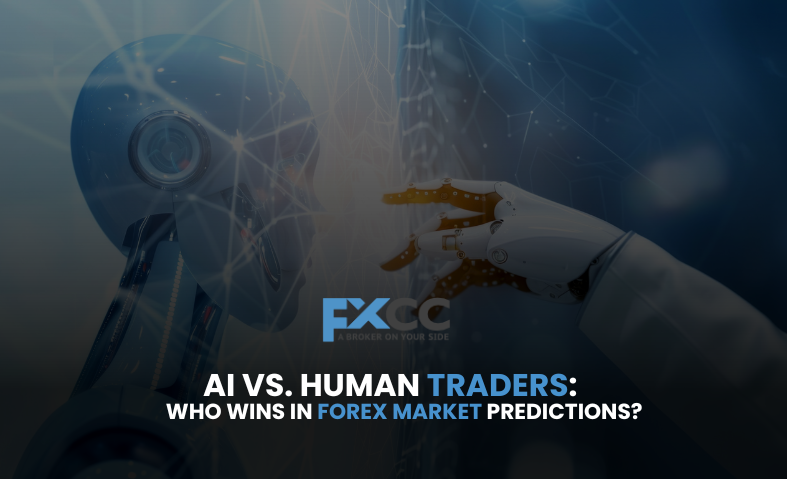The world of Forex (Foreign Exchange) trading has always been a high-stakes arena, where billions of dollars change hands daily. For decades, skilled human traders, armed with analytical prowess, gut feeling, and experience, have navigated its volatile currents. A powerful new challenger has stepped onto the scene: Artificial Intelligence (AI). As AI technology rapidly advances, a critical question arises: “AI vs. Human Traders: Who wins in Forex market predictions?” The answer, as of mid-2025, is more nuanced than a simple knockout.

The AI Edge: Speed, Data, and No Emotions
AI systems bring a formidable arsenal to the Forex market. Their primary strengths lie in areas where humans inherently fall short.
Blazing Fast Analysis: AI algorithms can process colossal amounts of data in milliseconds – far beyond human capability. This includes historical price data, economic indicators, news headlines from around the globe, and even social media sentiment. This allows AI to spot subtle patterns and correlations that might be invisible to the human eye, even with the most advanced charting tools.
Emotion-Free Execution: Human traders are often plagued by emotions like fear, greed, and overconfidence. Such emotional interference often results in rash choices, futile attempts to recover lost funds, or prematurely abandoning successful positions. AI, on the other hand, operates purely on logic and predefined rules. It doesn’t get tired, anxious, or excited, ensuring disciplined execution of strategies 24/7. This emotional detachment is a huge advantage in the fast-paced and psychologically demanding Forex market.
Adaptive Learning: Modern AI, especially machine learning models, can learn and adapt. They continuously refine their strategies based on new data and past performance, improving their predictive accuracy over time. Some advanced AI can even develop new trading strategies autonomously. This makes them highly dynamic tools in ever-changing market conditions.
The Human Advantage: Nuance, Context, and Unforeseen Events
Even with AI’s remarkable abilities, the role of human traders is far from over. They possess unique strengths that AI currently struggles to replicate.
Understanding Nuance and Context: While AI can process vast amounts of data, it often lacks the human ability to understand the nuance and context behind information. A news headline might be technically bearish, but a human trader can factor in the tone, the source’s credibility, or anticipate how market participants might interpret the news, even if it contradicts the literal meaning. AI might struggle with subtleties like geopolitical tensions escalating in an unexpected way or a central banker’s subtle shift in tone during a speech.
Adapting to Black Swan Events: “Black Swan” events – rare, unpredictable, and high-impact occurrences (like a sudden pandemic or an unprecedented natural disaster) – are difficult for AI to predict. AI models are trained on historical data, and if an event is truly unprecedented, the AI has no relevant past patterns to learn from. Human traders, with their broader general knowledge, common sense, and ability to think outside the box, can often adapt more flexibly and make intuitive decisions in such novel situations.
Creativity and Strategy Development: While AI can optimize existing strategies, the initial spark of a truly innovative trading strategy often comes from human ingenuity. Humans can conceptualize new ways of looking at the market, combine disparate pieces of information in novel ways, and develop entirely new trading paradigms. AI is excellent at executing and refining, but creativity remains a human domain.
The Evolving Battlefield: A Hybrid Future
As of 2025, the reality in Forex trading isn’t about one completely dominating the other. Instead, it’s about a powerful synergy.
Many successful trading firms and individual traders are adopting a hybrid approach. AI tools are used for:
- Data Aggregation and Analysis: Sifting through enormous datasets to identify potential trading signals.
- Sentiment Analysis: Determining the prevailing market emotion by analyzing news reports and social media trends.
- Automated Execution: Placing and managing trades with lightning speed and precision.
- Risk Management: Setting automated stop-losses and managing position sizes based on predefined parameters.
- Back testing and Optimization: Testing strategies against historical data to find the most robust settings.
Human traders then provide:
- Strategic Oversight: Monitoring AI performance, adjusting parameters, and intervening during unexpected market conditions.
- Discretionary Decision-Making: Making calls based on qualitative factors, geopolitical insights, or long-term macroeconomic trends that AI might miss.
- Crisis Management: Navigating “Black Swan” events and adapting to truly novel market environments.
- Innovation: Developing new hypotheses and strategies for AI to test and implement.

The Bottom Line
In the Forex market of 2025, neither AI nor human traders can claim an absolute victory in prediction. AI excels in raw processing power, speed, and emotional detachment, making it an invaluable tool for executing defined strategies and identifying patterns in massive datasets. However, humans retain the edge in understanding complex, nuanced contexts, adapting to unprecedented events, and driving true innovation in trading strategies. The future of Forex trading isn’t a competition, but rather a collaboration. The winning traders will be those who master the art of leveraging AI’s strengths to augment their own human intelligence, combining the best of both worlds to navigate the increasingly complex and dynamic global currency markets.


